| |
Page 1 of 29   |
| Author |
Message |
VK4AYQ
Guru

Joined: 02/12/2009
Location: AustraliaPosts: 2539 |
| Posted: 05:52am 09 Sep 2010 |
 Copy link to clipboard Copy link to clipboard |
 Print this post |
|
Hi All
I thought I would document this project as there has been a lot of interest in the recovery of batteries over the last few months.
Background:
The battery bank was located near Gladstone North Queensland at a camp site on a farm belonging to a friend of mine, we installed a little independence solar, windmill and backup diesel generator for the workmen on the farm as it is to far from power to be economical for an installation.
There is a pair of 80 watt solar panels with a 500 watt Chinese windmill and a 5 KVA auto start diesel generator as a backup. The batteries are 5 150 amp hour batteries powering a 12 volt Inverter 3500 watts.
All was going well for 12 months until the workers where pulled off that job onto another one for three months, on return the batteries where flat. As nothing was running off the batteries as consumption was turned of all should have been OK but Murphy stepped in. That was 12 months ago when my friend told me what happened, so I suggested we try and salvage the batteries.
Having heard nothing more about it from him I assumed he wasn't going to worry about it, and just get new batteries, how wrong can you be. He turned up at my place this week with the batteries in his 4x4 and said can you do anything with the batteries, after checking them not one of them would give a voltage reading, 0 volts not good.
For the interest of it I said I would try to get them going as much out of interest as hope of succeeding, so here we go.
Step one: check electrolyte levels, water level OK but wouldn't move the hydrometer as expected on any cell.
Step 2: hook the battery charger to each battery on 12 and 24 volt setting no current at all totally dead.
Step 3: King hit, connected my DC inverter welder with output voltage of 60 volts across the batteries one at a time 5 minuets on and 5 minuets off for an hour this started them absorbing a bit of current.
Step 4: hooked up the 24 volt charger to the battery with a desulphator for several hours, started absorbing 5 amps at 30 volts terminal voltage after 2 hours went up to 20 amps at 15 volts terminal voltage, at this point the charger cut out on overload so I went to 12 volt setting with a terminal voltage of 14 volts with a 12 volt desulphator 5 amps after an hour it was up to 15 amps.
This process was repeated on all batteries over the week and now 4 out of 5 have responded to the point that after sitting for 12 hours they maintain a terminal voltage of 13.1 volts on all four. The fifth battery has a dead cell and only reads 10.5 volts after sitting, so this I suspect was the cause of the batteries discharging in the first place, I have given it several king hits with the welder and am starting to get some cell activity on the dead cell, so will fool around with that later on.
Step 5: has been to rotate the chargers and desulphators on the batteries for 24 hours each, and there has been a noticeable decrease in the sulphate visible through the caps. I haven't given them a capacity test as yet to see how much capacity has recovered but would suspect around 30% at this time.
Step 6: next week connect in series parallel with my main battery bank with a charger connected to the 4 and a desulphator connected directly to them with an ammeter in series to monitor their interaction with the main bank with a 5 amp fuse for protection of the main bank should another cell go down, on past experience it may take several months to get them back to usable capacity.
Safety Considerations:
This process can be hazardous, so is conducted out doors with good ventilation wearing a safety face mask and protective clothing and be sure to turn off chargers before connecting to the battery terminals to avoid sparking.
If using the king hit method I use, be sure to time the on and off periods so as not to heat the battery beyond 40 degrees C. and observe the cell activity for an even reaction over all cells, do not leave on long enough to cause violent bubbling as the next step from that is a internal flash over and an explosion, better to take longer than blow the lot up. Do not go away and leave it on as you may forget the time and have a disaster as I did once. If the phone ring turn it all off.
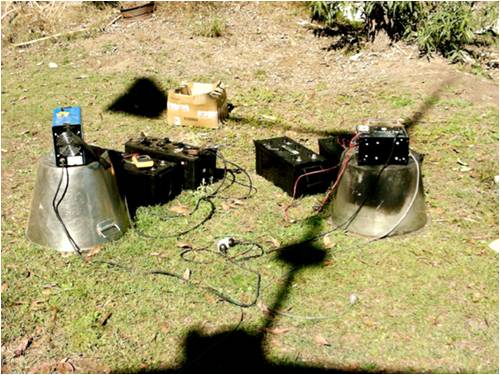
This is the motley collection outside my workshop.
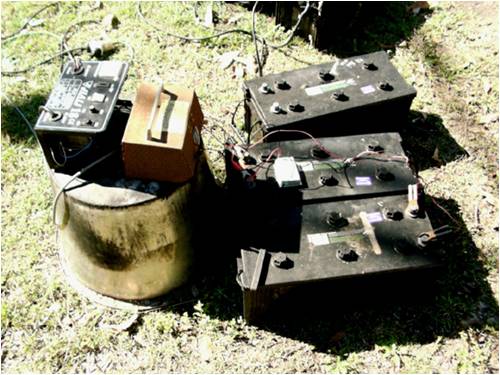
This is the chargers testing for the ability to absorb current No Luck.
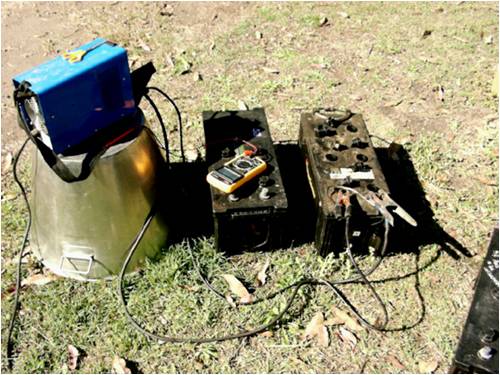
This is my little Inverter welder which has a open circuit voltage of 40 to 60 volts depending on the amp setting, it is handy for the king hit process described here and also for a battery charger on the main bank as required with an ammeter in series to monitor feed in current, it is rated at 160 amps 30% duty cycle and 80 amps 100% duty cycle. And its a good welder too, a real bonus.
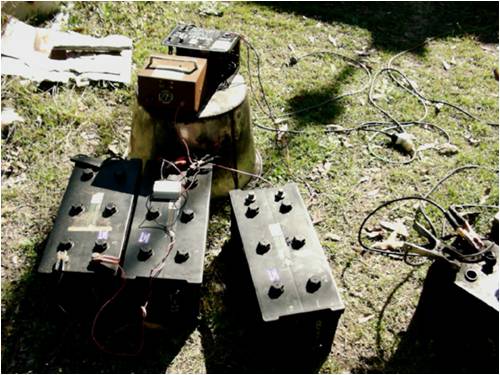
Here is the desulphator connected to the battery for 24 hours, as I have only one spare unit it has been a slow process to bring them up so far, when they are connected to the main bank they will have a dedicated 24 volt unit for a month or two.
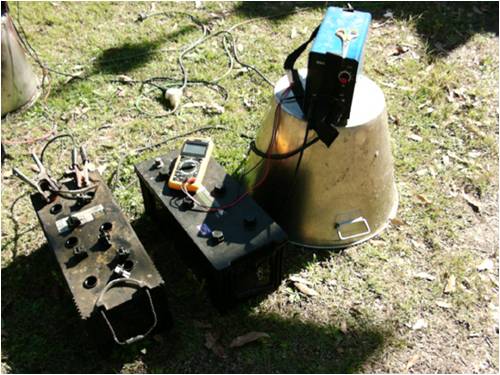
This is the dud battery, you will note that it is a different make and model and I suspect old stock from the seller hence the dud cell, maybe if a desulphator had been fitted from day one it would have prevented this expensive debacle, who knows.
The original power input was working OK solar at 10 amps regulated and wind turbine at 30 amps regulated, as the property is right on the coast the wind is very good with sea breezes nearly all the time around 8 ms, the unit was running a small fridge at 130 watts, four CFL lights 15 watts each and a TV at 100 watts, along with a radio and 2 way radio for comm's on the farm.
The generator had a cut in device should the batteries become discharged below 12 volts but that was turned off while the workers where away.
I hope the experience with the attempt to revive these batteries will be of interest.
All the best
Bob
Foolin Around |
| |
Bub73
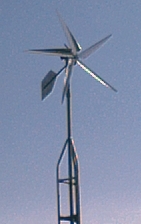
Senior Member

Joined: 10/12/2009
Location: United StatesPosts: 116 |
| Posted: 02:16am 10 Sep 2010 |
 Copy link to clipboard Copy link to clipboard |
 Print this post |
|
Bob;
Thanks for posting this and let us know how it all turns out; even the dud.
Bob |
| |
matt down south
Regular Member

Joined: 20/10/2007
Location: AustraliaPosts: 50 |
| Posted: 09:49am 10 Sep 2010 |
 Copy link to clipboard Copy link to clipboard |
 Print this post |
|
good read Bob and should help a few people sort out old batteries,im glad all my dump/scrappie batteries ive got so far only need a good desulfation/charge being above 2 volt per cell
matt |
| |
VK4AYQ
Guru

Joined: 02/12/2009
Location: AustraliaPosts: 2539 |
| Posted: 12:12pm 10 Sep 2010 |
 Copy link to clipboard Copy link to clipboard |
 Print this post |
|
Hi Matt
Thanks Matt, I decided to do these as they are about the worst case I have come across and if they can be be rescued to a usable capacity it will demonstrate that it can be done, batteries are a expensive item these days and to be able to get a bit more use is good value for a few hours work.
All the best
Bob
Foolin Around |
| |
matt down south
Regular Member

Joined: 20/10/2007
Location: AustraliaPosts: 50 |
| Posted: 07:00am 11 Sep 2010 |
 Copy link to clipboard Copy link to clipboard |
 Print this post |
|
yeah good large deep cycle batteries would proberly be the dearest part of a stand alone solar system now days with chinese panels being so cheap to buy hence all of us keeping i eye out for 6-7 year old cells that get replaced regardless of use which is a good thing for us that do it for a hobby or just a cheap stand alone system which is not hard to piece together with basic skills that the solar installers charge the earth for
matt |
| |
isaiah

Guru

Joined: 25/12/2009
Location: United StatesPosts: 303 |
| Posted: 10:13am 11 Sep 2010 |
 Copy link to clipboard Copy link to clipboard |
 Print this post |
|
Bob
That DUD battery ou have there looks just like the dud I have and posted about awhile back.
So far its not coming back but I think we have one of those 110 volt stick welders so maybe Ill dig it out and have a look at it.
If you hear a large decibel event down there you'll know it didn't go well . Thank you for the post on this subject and information.
For the other readers of this subject be careful when a battery blows up it is not a fun experience and the damage can last a lifetime !!
Battery acid burn is no fun and bad news if you get it in your eyes it could be blinding.
We have saved some and lost some more losses than saves but the losses can be scrapped.
URL=http://www.motherearthnews.com/Renewable-Energy/1973-11- 01/The-Plowboy-Interview.aspx>The Plowboy Interview[/URL> |
| |
VK4AYQ
Guru

Joined: 02/12/2009
Location: AustraliaPosts: 2539 |
| Posted: 10:54am 11 Sep 2010 |
 Copy link to clipboard Copy link to clipboard |
 Print this post |
|
Hi All
One week of charge cycling and the four batteries have stabilized at 13 . 2 volts after sitting for 24 hours, but there is a lot of sulphate still visible through the caps so it time to hook up to the main bank and continue desulphating.
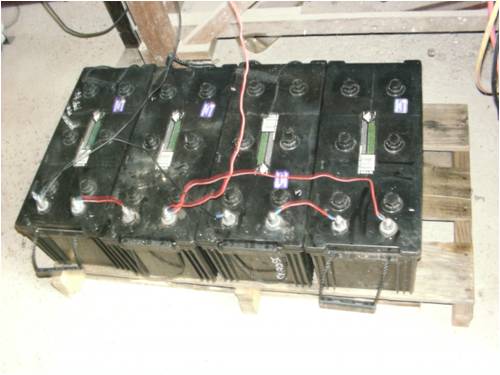
The batteries are connected in series parallel to give a 24 volt nominal combination.
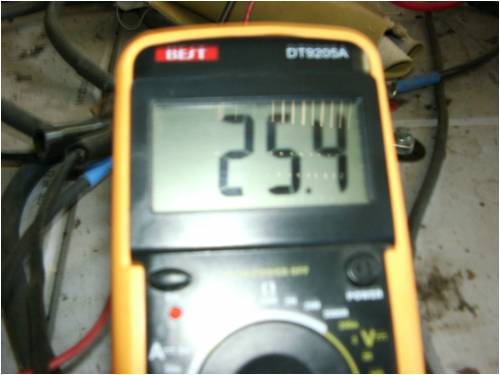
Float battery voltage of the bank while running a grid feed inverter with solar input. The batteries will be cycled to 28.5 volts once a week, I have found that with the desulphator in place there isn't so much need to go over 30 volts to equalize.
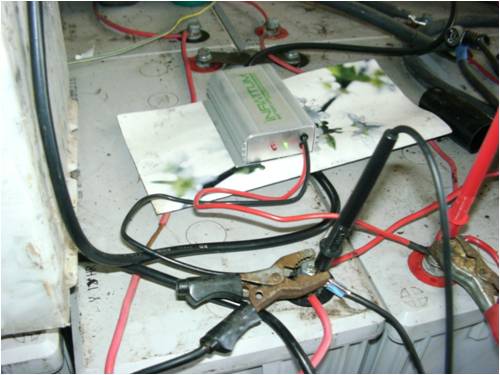
The desulphator in place across the lead to the batteries to be recovered. this is connected across all four batteries for a start, after a week I will look at the plates and see how the crystals of sulphate are performing.
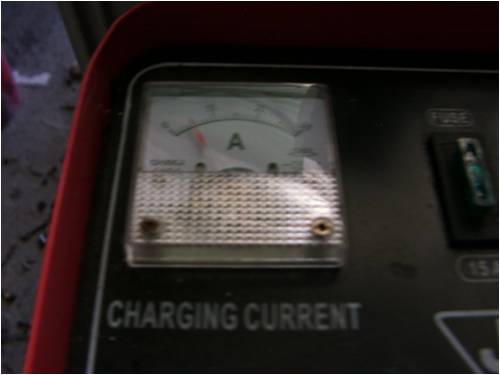
Trickle feed into the whole bank total of 4 amps into approx 5000 amp hour battery, just enough to keep the voltage up to where the desulphator cuts in at 25 volts.
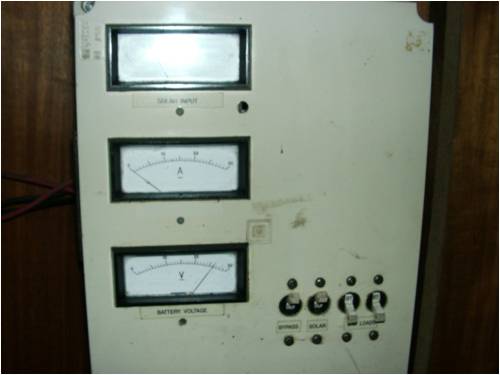
Solar input panel sorry the flash hid the gauge reading that was 10 amps at 4 pm so input from solar was minimal and the wind stopped so nothing from the windmill.
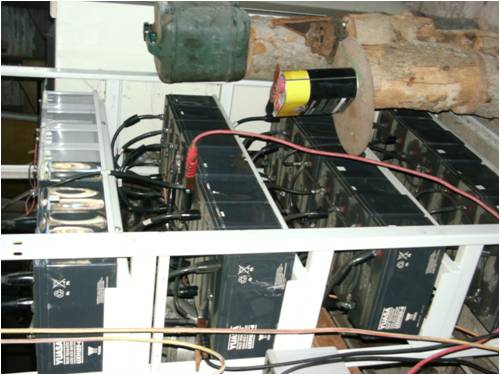
This one of four battery banks that the batteries are connected to, these where revived last year from being tired but not in a poor condition as the ones being treated at the moment.
The batteries will be left in place for several months now to just gently desulphate, I will move the desulphator onto each pair every few days to allow more direct contact with the battery pairs and if the cells in one or other need a bit of a boost I will connect a 12 volt desulphator unit across each battery for a few weeks.
All the best
Bob
Foolin Around |
| |
VK4AYQ
Guru

Joined: 02/12/2009
Location: AustraliaPosts: 2539 |
| Posted: 11:02am 11 Sep 2010 |
 Copy link to clipboard Copy link to clipboard |
 Print this post |
|
Hi Isaiah
I don't hold out much hope for the dud at this point in time, but will persist with it for a while as it is now bubbling slightly on the bad cell, the other cells have responded quite well so its worth a try. If it doesn't come good on all cells I might remove the bad cell and use it as a ten volt power supply to run the control relays in the load switching and regulation section of the solar wind combination.
All the best
Bob
Foolin Around |
| |
isaiah

Guru

Joined: 25/12/2009
Location: United StatesPosts: 303 |
| Posted: 02:59am 12 Sep 2010 |
 Copy link to clipboard Copy link to clipboard |
 Print this post |
|
Bob,
How do you open the top to remove a cell?
The old ones had that tar like stuff in a grove you could cut it out but these new battery's are all pretty much plastic or some form of rubber.
If you can take the bad cell out why not put a good one back in? providing you have a Donner battery.
If you cut with a saw or something the shavings would have some battery acid in them?
Wouldn't want that flying all around the yard.
I would need chest waders or a skin divers suit ' 'Edited by isaiah 2010-09-13 'Edited by isaiah 2010-09-13
URL=http://www.motherearthnews.com/Renewable-Energy/1973-11- 01/The-Plowboy-Interview.aspx>The Plowboy Interview[/URL> |
| |
VK4AYQ
Guru

Joined: 02/12/2009
Location: AustraliaPosts: 2539 |
| Posted: 02:54pm 12 Sep 2010 |
 Copy link to clipboard Copy link to clipboard |
 Print this post |
|
Hi Isaiah
This is a plastic top one as you say, and if you are real keen you can cut the whole top off the battery after drilling off the terminals, but I'm not that keen. There was a article on doing it on the forum a year ago I think.
To remove the one cell I drill a hole on each corner in the top plate as you can see from the stress mark where the divisions are, several more holes to allow the tip of a small saw in and cut along the divider, then remove the top piece and cut the connectors to the top of the plates both sides and lift the old cell plates out, sometimes you can correct a short by slightly moving the plates, but on this one I don't hold to much hope for that. After rinsing the cell case out solder a bridge between the terminals that where cut and you have a 10 volt nominal battery. If all the battery was in good condition apart from this cell you could replate it if you can get the same size plates but I think its to much trouble. I have seen people use a cell salvaged from another battery and bridge it in to the battery but that's dessert island stuff as far as I am concerned.
The top can be stuck back on with the glue they use to install windscreens with also some grades of silicone that are made to bond to the plastic.
On the old lighting plant batteries I serviced years ago I had plate and connector moulds and could make up new plates and fit them, on that size battery it was practical but not on these small ones.
All the best
Bob
Foolin Around |
| |
isaiah

Guru

Joined: 25/12/2009
Location: United StatesPosts: 303 |
| Posted: 08:35am 20 Sep 2010 |
 Copy link to clipboard Copy link to clipboard |
 Print this post |
|
Hey Bob how is the dud battery doing now?
Do you have any knowledge on the old Tunger battery chargers that uses two bulbs?
We are having troubles getting one side to have any out put and it looks like it might have a wire missing.
We did get that old one bulb Tunger working with an updated rectifier.
Bub's using it every day.' ' '
URL=http://www.motherearthnews.com/Renewable-Energy/1973-11- 01/The-Plowboy-Interview.aspx>The Plowboy Interview[/URL> |
| |
VK4AYQ
Guru

Joined: 02/12/2009
Location: AustraliaPosts: 2539 |
| Posted: 11:09am 20 Sep 2010 |
 Copy link to clipboard Copy link to clipboard |
 Print this post |
|
Hi Isiah
The Dud battery is chugging along but it is a bit slow to respond, the flat cell is responding a bit and showing a bit of acid activity, no reading on the hydro yet, I will give it a couple more weeks before deciding to scrap or cut it. The plates are recovering to some degrees from the sulphate and the battery has a standing voltage of 11.5 volts now indicating a small conduction improvement on the dud cell.
The other four batteries are responding OK with a decrease in the sulphation in all cells, the hydro readings are low due to the acid being converted to sulphate, it will take a while for the acid to reconstitute, I am light cycling them with a 300 watt GFI, 8 hours discharge cycle and 16 hours charge cycle, this means going to 26.5 volts on charge and down to 25 volts on discharge.
I am afraid Im not much help on the charger can only suggest that you check the wires back to the ,transformer as it may have a dead leg on the transformer. Mine had several contact related problems on the socket due to combination of surface corrosion and dry joints.
If you have access to a cro it will read wave form on all legs at very high impedance.
Mine had a replacement transformer indicating that it may have a transformer age problem caused by heat cycling and transformer humm wearing through the wire insulation as they are loose wound and not potted. Mine was anyway.
All the best
Bob
Foolin Around |
| |
AMACK

Senior Member

Joined: 31/05/2009
Location: AustraliaPosts: 184 |
| Posted: 01:04pm 24 Sep 2010 |
 Copy link to clipboard Copy link to clipboard |
 Print this post |
|
Hi Bob. I have read your posts on Battery's and how to pull them back from death and went to Jaycar and got a desulphator to give it a go. It was around $79.00 for the kit so I hope it works 
It is on an old battery that was used in a solar powred bird system, to keep the birds off the fruit that was left go as it did not work. It has been running now for 2 days and will see what it is going Monday when I go into work. It has a position for a charger that limits it down to 1 amp.
Amack
*Note to self
1. Make it thick
2.Make it heavy.
3.Make it stronger than it should be.
4. Don't rush the first job as the second job will cost more and take mor |
| |
VK4AYQ
Guru

Joined: 02/12/2009
Location: AustraliaPosts: 2539 |
| Posted: 01:36pm 24 Sep 2010 |
 Copy link to clipboard Copy link to clipboard |
 Print this post |
|
Hi Amack
I will be interested as to how yours goes, looks like 4 of the five batteries have responded, number five has one dead cell and I believe it was the cause of the initial flattening of all five. They had a 100 watt solar cell on them all the time and with not being used it should have floated the lot but the went dead.
I am giving the one with a dead cell a go for another couple of weeks as the cell is showing a bit of activity and the standing voltage is up to 11 volts now from 10 volts several weeks ago, just for the exercise I suppose.
The low amps you mention isn't a problem as it only requires a float of 13 volts to activate the desulphation. You may need to give it a bit more initially to get the standing volts up, should 12.3 volts after standing overnight without charge. If its less than that its tired, 10 volts or so indicates a shorted cell.
I hit mine with 30 amps for 30 seconds twice a day just to give a bit more cell activity as its a 150 ah battery.
All the best
Bob
Foolin Around |
| |
AMACK

Senior Member

Joined: 31/05/2009
Location: AustraliaPosts: 184 |
| Posted: 01:48pm 24 Sep 2010 |
 Copy link to clipboard Copy link to clipboard |
 Print this post |
|
Bob, I too gave them a 30 amp kick with the woods charger for a bit. It brought the desulphater up to 60 Volt for a bit. It has only been going for 2 days and it is hard t say yet if it works but I will give it a good go.
AMACK
*Note to self
1. Make it thick
2.Make it heavy.
3.Make it stronger than it should be.
4. Don't rush the first job as the second job will cost more and take mor |
| |
VK4AYQ
Guru

Joined: 02/12/2009
Location: AustraliaPosts: 2539 |
| Posted: 06:04am 29 Sep 2010 |
 Copy link to clipboard Copy link to clipboard |
 Print this post |
|
Hi all
I finally gave up on battery five and pronounced it dead "RIP" till the scrap man comes again.
I was going to use the other five cells as a power supply but the poor condition of the plates didn't warrant the work, so it can now go to china and be recycled into new batteries to be exported to us dummies in Australia.
The other four batteries are slowly cleaning up the plates and responding, I will give them a load test in three weeks but would say they are at around 50% capacity already,
All the best
Bob
Foolin Around |
| |
dwyer
Guru

Joined: 19/09/2005
Location: AustraliaPosts: 573 |
| Posted: 06:39am 29 Sep 2010 |
 Copy link to clipboard Copy link to clipboard |
 Print this post |
|
Hi Bob
Is anyway can you able to rebuilt the Batteries like back in the old days??  and is your new mill is running yet and we had lighting storm went over our area Lockyer Vally last night. and is your new mill is running yet and we had lighting storm went over our area Lockyer Vally last night.
Dwyer
|
| |
VK4AYQ
Guru

Joined: 02/12/2009
Location: AustraliaPosts: 2539 |
| Posted: 07:46am 29 Sep 2010 |
 Copy link to clipboard Copy link to clipboard |
 Print this post |
|
Hi Dwyer
I did rebuild the lighting plant batteries years ago as I had the molds to make new plates and connectors, but the new batteries aren't made to service like the old ones, with the manufactures now going offshore for more profit from cheaper labor, who knows what will happen in the future.
One battery type I experimented with was the rolled plates with fiber glass separators, they worked good but suffered lower capacity due to lack of spongy lead fill in the plates so their effective plate area was less. I had the bright idea to use them in my car but they where to heavy for their capacity. Could be alright for power batteries though where weight isn't a concern, and they are certainly much cheaper to make than some of the single cells around now.
I haven't got my mill up yet as been sick for a couple of weeks so that slowed me down.
Have to go to Gatton tomorrow to get the new bearings and then I can put it back together, I have documented all the things I have done to the generator and might post it on the forum for the interest of all. I feel really happy with the little mill, now that some of the Chinese engineering issues are sorted out it will be a real beauty for low wind energy capture.
I will get another one next month to power an electric car I'm tinkering with and will use it on 48 volts for the car battery, and in the mean time with a down converter to also charge the 24 volt house batteries.
I just need to extend the blades to 2.8 meters and fit tip plates to improve low speed torque on this one and put it up, next couple of weeks should see it out. Alsp have to go and see Phill and get some more caps as I used the caps for this one on my other mill.
I copped that storm too but no wind to speak of, plenty of rain though, nearly 2 inches.
All the best
Bob
Foolin Around |
| |
dwyer
Guru

Joined: 19/09/2005
Location: AustraliaPosts: 573 |
| Posted: 01:49pm 29 Sep 2010 |
 Copy link to clipboard Copy link to clipboard |
 Print this post |
|
Hi Bob
You can get bearing at Gatton bearing (if i am correct) the best price at Western Drive Gatton just cross the road from Valley Irrigation shop if suit you. Sorry to hear been sick for couple of week same with myself slowing down too but never mind and Phill's mill as l am working on at the moment will be ready by end of the week. L didnít extend my blades is 2.660 and lighter too with 12 deg angle as Phill's requirement and other modification to stator, slip ring, and blades will be seen by Phill first before l able release to Backshed member if is ok by Phill.About ball bearing, best way to remove the bearing is heat up the bearing housing cover as easy to come out with light hammer and tapping with wooden dowel on the bearing until it come off also must have tube underneath to support bearing cover from breaking.
Batteries I have is 2 volt 200 amp and going to open up with hot wire as knife and see if worthwhile to rebuilt on not. I do remember when l was small kid in Melbourne and watching men working on recondition lead battery back in old days and it all very simple . 
Regard Dwyer
|
| |
VK4AYQ
Guru

Joined: 02/12/2009
Location: AustraliaPosts: 2539 |
| Posted: 03:10pm 29 Sep 2010 |
 Copy link to clipboard Copy link to clipboard |
 Print this post |
|
Hi Dwyer
Batteries are very simple in construction, but the new ones are sealed to keep us out, the old ones you mention are hard rubber case with the tops held in by tar. We used to rebuild them too as you could get plate kits very cheap, so it was a proposition. These days the relative cost of car batteries is very cheap so wouldn't be worth rebuilding except for the fun of it.
I remember paying 30 pounds for a new battery for my car, that's when I was an apprentice earning 12 pounds a week.
I have rewired the stator so I can do star or delta as required.
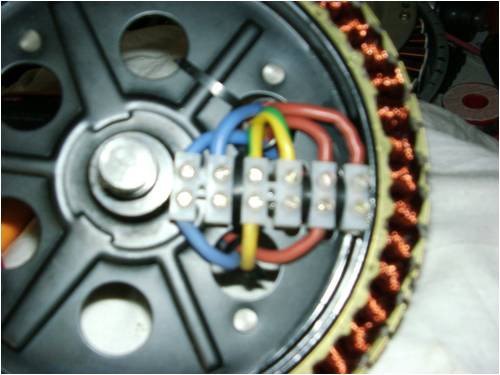
I may fit heavier slip rings too as the ones fitted are a bit light for 24 volt, I think they are for 48 volt where the amps are half that of a 24 volt system. I have to re do the angle on the furling as per Phill design also.
I am mounting it on the shed roof so have to extend the tower a bit for more height, fun and games.
All the best
Bob
Foolin Around |
| |
| |
Page 1 of 29   |

